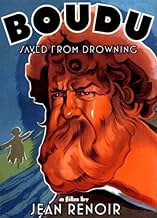IMDb RATING
7.2/10
6.4K
YOUR RATING
A bookseller saves a tramp from drowning and shelters him, but the tramp's odd behavior starts to wear everyone down.A bookseller saves a tramp from drowning and shelters him, but the tramp's odd behavior starts to wear everyone down.A bookseller saves a tramp from drowning and shelters him, but the tramp's odd behavior starts to wear everyone down.
Charles Granval
- Édouard Lestingois
- (as Charles Granval de la Comédie Française)
Jacques Becker
- Le poète
- (uncredited)
Georges D'Arnoux
- Un invité à la noce
- (uncredited)
Régine Lutèce
- La promeneuse
- (uncredited)
Jane Pierson
- Rose, la voisine
- (uncredited)
- Director
- Writers
- All cast & crew
- Production, box office & more at IMDbPro
Storyline
Did you know
- TriviaFrench audiences were outraged by Boudu's antisocial behavior to the extent that police had to be called to several theaters to restore order. In some areas the film was immediately pulled because of its polarizing effect.
- Quotes
Chloë Anne Marie, la bonne: Why have a piano if no one plays it?
Édouard Lestingois: Even so, we have a piano because we are respectable people.
- Alternate versionsThere is an Italian DVD edition of this movie, distributed by DNA Srl. The movie was re-edited with the contribution of the film history scholar Riccardo Cusin. This version is also available in streaming on some platforms. This DVD also contains another movie by Jean Renoir: Toni (1935).
- ConnectionsEdited into Histoire(s) du cinéma: Seul le cinéma (1994)
- SoundtracksGénérique
Performed by Raphaël
Featured review
Actually it's hard to overpraise any of Jean Renoir's movies. They all have, but this one particularly, a wonderful openness, and thereby freedom for characters to make fresh choices. Propped in a door frame, cleaning his shoes, whatever Boudu does seems unplanned, Renoir saying "Why not?" to anything Michel Simon invented in the liberty of his hair and costumes. Freer maybe than the more carefully scripted inventions of Chaplin and Keaton; right up there with Jean Vigo's "Zero de conduite." Renoir could do crowds; he could do both boating on a stream and a country wedding. He could do human beings, which gives us humanity. Art needs this bouduisme, and long may Boudu live, preferably on a good DVD.
- How long is Boudu Saved from Drowning?Powered by Alexa
Details
- Release date
- Country of origin
- Language
- Also known as
- Budi spasen iz reke
- Filming locations
- Berges de la Seine, Paris, France(Exterior)
- Production companies
- See more company credits at IMDbPro
Box office
- Gross worldwide
- $2,805
- Runtime1 hour 25 minutes
- Color
- Aspect ratio
- 1.19 : 1
Contribute to this page
Suggest an edit or add missing content



























